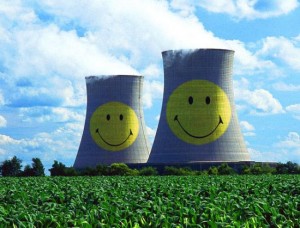Waste Not…
Please, No More Nuclear Options
by Brian J. Trautman
The Fukushima Dai-ichi disaster in Japan is a tragic reminder of the risks and hazards associated with nuclear energy production.  Nevertheless, the United States has reaffirmed its commitment to expanding nuclear power domestically. Last year the Obama administration announced billions of dollars in new loan guarantees for reactor construction and billions more in assistance is being requested from the Congress. This is waste.
Nevertheless, the United States has reaffirmed its commitment to expanding nuclear power domestically. Last year the Obama administration announced billions of dollars in new loan guarantees for reactor construction and billions more in assistance is being requested from the Congress. This is waste.
While the U.S. remains committed to nuclear power, many countries recognize that innovative approaches and sustainable solutions to their growing energy demands must not include atomic options. Advanced countries like Germany and Switzerland are phasing out nuclear power. Other nations, such as Australia, Ireland, and Norway, remain opposed to going nuclear. Italy abandoned its nuclear program in the 1980s, and Italian voters have overwhelmingly rejected a government proposal to restart the program.
The U.S. is the world’s largest producer of nuclear power, with 104 commercial reactors operating in 31 states. Many are nearing or at the end of their original 40-year life-span and about one-fifth of them are of the same flawed design as a reactor that melted down at the Fukushima plant.
Nuclear power is neither a “clean alternative†to fossil fuels nor a safe one. According to the Nuclear Regulatory Commission, leaks of radioactive tritium have occurred at three-quarters of the nation’s nuclear power sites. The National Academies’ National Research Council has found that there is no “safe†level of radiation. Any exposure creates an increased risk of cancer. This alarming medical finding has been argued for decades by physician and renowned anti-nuclear campaigner Helen Caldicott.
Many of the U.S. reactors leaking radioactive material are located near large fresh-water aquifers. These sites include the 40-year-old Vermont Yankee plant and the nation’s oldest plant, Oyster Creek, located in southern New Jersey. In October 2010, a spill at the Knolls Atomic Power Laboratory in Niskayuna, NY resulted in about 630 gallons of radiation-tainted water containing plutonium discharged into the Mohawk River, above drinking water intakes for tens of thousands of NY Capital Region residents. According to Dr. Caldicott, “one millionth of a gram of plutonium is carcinogenic.”
A number of U.S. plants are situated on or near geologically active faults or just off the coast, and some have both features in common. Harvey Wasserman, author and long-time environmental and energy activist, contends that, “Had an earthquake with a magnitude of Japan’s hit off the California coast, it could have ripped apart at least four coastal reactors and sent a lethal cloud of radiation across the United States.†The 36-year-old Indian Point Energy Center, located on the bank of the Hudson River and just 25 miles north of New York City, sits on two fault lines and has been called the most at-risk plant in the country.
According to the Nuclear Energy Institute, the U.S. has generated more radioactivity from nuclear power and weapons production than any other nation. Currently no solution exists to the problem of storing the massive amounts of radioactive waste currently sitting in spent fuel pools at the nation’s nuclear reactors. This waste will continue to accumulate and will remain in storage at U.S. nuclear sites indefinitely.
Besides the huge health and safety risks, nuclear energy programs contribute to the proliferation of nuclear weapons worldwide. Educator and author Dr. Betsy Hartmann warns, “nuclear power, waste and weaponry threaten us all, as well as generations to come…. It’s a peace and security issue … nuclear power fuels the atomic weapons industry, facilitates nuclear proliferation, and increases vulnerability to terrorist attacks.â€
While atomic power has been a destructive force against people and nature, the anti-nuclear movement has actually been remarkably successful. Mr. Wasserman explains: “No reactor ordered in this country since 1974 has been completed. In that year, Richard Nixon promised 1,000 atomic reactors licensed to operate by the year 2000…. There are many reasons those 896 reactors went missing. Number one is the fact that the No Nukes movement stopped the industry from gouging from the government the trillion or more dollars it would have taken to build that fleet.â€
If the anti-nuclear movement is to survive and thrive and ultimately achieve the objective of a nuclear free nation, it must grow its numbers and presence by increasing public awareness of the dangers and costs of nuclear power and of the benefits and availability of green energy technologies. As every other successful movement for social and environmental justice has demonstrated, this movement must educate, agitate, and persuade through nonviolent and peaceful methods, even in the face of opposition, adversity and indifference. It is by these means that nuclear will eventually be taken off the table as an option toward meeting our country’s energy demands and achieving energy independence.
Brian J. Trautman is a U.S. Army veteran and a peace educator/activist. He teaches peace and world order studies at Berkshire Community College in Pittsfield, MA. Trautman is on the board of the Peace and Justice Studies Association (PJSA) and is a member of Veterans for Peace and Berkshire Citizens for Peace and Justice. This article was distributed by PeaceVoice.
